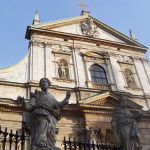The church in Chotyniec

The inhabitants of Chotyniec, a village near the border with Ukraine, recall a legend about their local church, which is said to have been dragged in by oxen, and its location was supposed to be chosen by the Mother of God (the church used to be 8 km further away). The church was first mentioned in 1515, however, historians have dated the wooden building back to 1615.
The Greek Catholic (and for a short period Roman Catholic) Mother of God church is built with interlocking corners. The tripartite building is made up of the higher and the bigger nave and two lower and smaller sections: the altar and the so-called babiniec, the women’s section.
Throughout its existence, the place of worship underwent numerous reconstructions – in 1925 it was augmented by a tin-roofed vestibule which stands in contrast to the wooden shingles of the domes. The interior of the church contains a polychrome from the 18thcentury depicting the Day of Judgement, a five-rubric iconostasis from the 17th century and the remnants of the Roman Catholic church: a painting of the Black Madonna of Częstochowa, figures of saints and a monstrance. A wooden bell tower, brought in from Torki, stands in the graveyard beside the church.
In 2013, the church was listed as a World Heritage site by UNESCO.
The church in Dębno Podhalańskie

St. Michael Archangel’s Church is an over five-hundred-year-old Roman Catholic church encircled by trees classified as natural monuments. Made of larch and fir (the nails were replaced with wooden dowels), the church has survived the trials of time practically unchanged. In 1601, it was supplemented with a turret tower with an overhanging top floor with a pyramidal dome, the 17th century also saw the construction of the southern vestibule. In 2003, the church was listed as a World Heritage Site by UNESCO.
Its interior, with an extraordinary gothic-renaissance polychrome from 1500, may be visited in the spring and autumn (the church is closed in winter to protect it from humidity). The painting was made using cardboard or leather stencils, 77 floral, geometric, figural and animal motives in 33 colours can be admired on the ceiling and the walls. The famous glockenspiel from the 15th century (there may be only five such glockenspiels in the world!) is located near the altar. It is unique because the sounds it produces defy the laws of physics: the thickest and longest key gives a high tone, the thinnest and shortest a low tone. The rood beam holds up the oldest monument of the church – a cross from 1380, which, according to legend, was brought to the town by the waters of the Białka River.
According to a different folk legend, the church was supposed to be built by bandits near the oak on which St. Michael Archangel revealed himself. This is also where the film bandit Janosik married Maryna.
The church in Haczów

Considered the oldest wooden church in Poland until recently (a title taken away by the church in Tarnowo Pałuckie near Poznań), it’s one of the biggest buildings of its kind in the world. In 1388, the king of Poland Władysław Jagiełło established a parish in Haczów, and the first gothic church was constructed there. In 2003, it was placed on the UNESCO list, and ten years later a monograph about the temple was compiled by Piotr Łopatkiewicz.
In the 17th century, the fir building was augmented by a tower with slightly sloping walls and sobotas (sobota is a type of a wooden arcade) in order to fit more churchgoers. During its last renovation, the planking in the framework construction was swapped with much lighter planks. The church has the oldest known interior decorations (from 1494). The priceless polychromes depict the Passion, the Coronation of the Blessed Virgin Mary, the assassination of Saint Stanislaus and Saint Michael the Archangel. A discovery by Professor Jerzy Gadomski made the reconstruction of the nave ceiling polychrome possible: he found eleven loose boards in the church attic, below them a gothic figural painting. While the graceful Pietà was supposed to be brought to the Haczów church by the waters of the Wisłok River.
The Church of Peace in Jawor

The Lutheran wooden church in Jawor called the Church of Peace was built under the Peace of Westphalia. The Holy Roman Emperor Ferdinand III gave a green light to the construction of three Protestant churches (one in Głogów – burnt down, one in Świdnica – still standing today). Not without restrictions – the churches were supposed to be constructed over a year, at the expense of the faithful, outside the city walls, from perishable materials, and they couldn’t have any towers or bells.
The Church of the Holy Spirit in Jawor was built between 1654 and 1655 based on a design by Silesian architect Albrecht von Säbisch, while the tower was erected in 1707. The inconspicuous temple can accommodate six thousand people. Its space is considerably increased by four levels of galleries in the aisles. The balcony parapets are decorated with scenes from the Old and the New Testaments, and the ceiling is embellished by a coffering with floral motives. The church’s rich baroque furnishings still exist today – the altar, the baptismal font and the pulpit.
In 2001, the Churches of Peace were placed on the UNESCO list. Jawor hosts Peace Concerts organised between May and September with chamber music performed by Polish and international artists.
The mosque in Kruszyniany

The distinctive green (the colour of Islam) covers the 18th-century Tatar mosque. If it weren’t for the crescents on the towers, it could be easily mistaken for a village church. According to the religious commandment, women and men were supposed to pray separately, so the inside of the building is divided into two. The room where the main service takes place (the men’s part) has a mihrab – a niche in the wall turned to Mecca. A mimbar, a raised platform from which an Imam preaches, is at the centre of the mosque. The floor is covered with rugs, and the walls with decorative tapestry are inscribed with verses from the Koran (so-called muhirs).
The mosque in Kruszyniany is the older one of the two wooden Tatar mosques in Poland – the other one is in the nearby Bohoniki. The Tatars settled in Podlachia by virtue of a privilege granted by king Jan III Sobieski. Once a considerable community, today, their population amounts to just a few families. They follow only some of Islamic laws, like the traditional ceremonies – giving names to new-borns, weddings and funerals.
The Orthodox church in Owczary

The classic Lemko church form of the Protection of Our Most Holy Lady Orthodox church in Owczary catches one’s attention: the tripartite tented roofs cover the altar section and the babiniec. The nave from 1652 (the year of construction) is the oldest part of the church.
Its furnishings are extremely valuable, especially the complete baroque iconostasis from the 18th century. Jan Medycki from Muszyny created the majority of the icons decorating the gates and illustrating the most important events of the liturgical year, the rest was painted by an anonymous artist. The aisles contain paintings of the Virgin Mary and Child and Saint Nicolaus. Polychromes with figural and ornamental motifs were created in 1938 on the 950th anniversary of the baptism of Rus.
The 1980s saw a major renovation (the shingle roofing was replaced) which was awarded the Prix Europa Nostra in 1994. The building was placed on the UNESCO list in 2013. It’s shared by the Roman and the Greek Catholic Churches.
The filial church in Sękowa

Its towering silhouette has been immortalised in Stanisław Wyspiański’s, Józef Mehoffer’s and Włodzimierz Przerwa-Tetmajer’s paintings. The church has inspired architects who designed new wooden temples (for example Bogdan Treter, the architect of the church in Jabłonka built in 1936). The Roman Catholic Saints Philip and James Church in Sękowa was built in 1520. With its framework construction, the larch hand-hewn logs are nearly entirely hidden under a steep shingle-covered roof resembling a tent. Initially, the church didn’t have a tower, however, in the 17th century, it was constructed using a post and beam construction and wide, open sobotas were added.
The interior is not as impressive. World War I brought destruction to the church, only a late-gothic stone baptismal font, ornamented portals and a fragment of the 19th century polychrome survived. Despite the damage, the church has been carefully renovated, and the maintenance work was awarded the Prix Europa Nostra in 1994. The unique architecture was appreciated by UNESCO who put it on their list in 2003.
The church in Szalowa

The most magnificent late-baroque wooden church in Poland is located in a small village in the Low Beskids mountain range. The uniform baroque-rococo interior is kept in white-blue-gold tones. The trompe-l’œil polychrome brings out the details: ornamental stripes, shields with aphorisms, architecture motifs, a rainbow wall with a carved Crucifixion group with Jerusalem in the background. An eye-catching painting depicts a soldier striking crucified Jesus with a lance (the soldier’s hand and the lance are carved). A sense of movement is achieved through a wavy line of arcades with diagonal pillars – distinctive of the then monumental architecture.
The Roman Catholic St. Michael Archangel’s church had been built between 1736 (or 1739) and 1756 with fir and its model can been seen at the National Museum in Kraków. It has a three-aisled Basilica body and a façade with two towers and three narthexes covering the entrances to the aisles. The central space of the triangular dome is the base for a unique figure of St. Michael Archangel fighting Satan disguised as a dragon.
The Orthodox church in Turzańsk

Stone steps lead to a graveyard behind which a former Greek Catholic church, today St. Michael Archangel’s Orthodox church, is located. It is classified as a so-called Lemko church – eastern, thus towerless. It was constructed between 1801 and 1803 replacing the previous one built in the 16th century. The tripartite church (with a presbytery and two sacristies) with a three-piece single-ridge roof (since 1913 the church has had a sheet metal roof) and three tented roofs was also added to the UNESCO list in 2013.
Its interior is decorated with a figural-ornamental polychrome. In 1895, Josif Bukovchyk painted the polychromes depicting not only religious scenes but also a mountain landscape and the local people. The ledge of the choir is adorned with a painting of a Lemko man planting grain and the north wall of the matroneum – Jesus Christ visiting a Lemko family. Their creator also painted the icons in the iconostasis from the first half of the 19th century.
Vang stave church

The incredible Nordic Romanesque monument was nearly demolished. It was built at the turn of the 12th century in Vang (now Grindaheim in south Norway) by an eponymous lake. In the 19th century, the temple ceased to satisfy the needs of the local villagers (it was too small, and the maintenance costs were too high), so there were plans to demolish it. After the painter Johan Christian Dahl intervened, the church was purchased by King Frederick William IV of Prussia – it cost 427 marks. It was transferred in boxes to Szczecin and then to the Royal Museum in Berlin, and finally, with the efforts of Friederike von Reden of Bukowiec, the church reached the middle of the road between the towns Karpacz and Śnieżka.
The gift to the Evangelical community who didn’t have a temple of their own is built from Norway pine without the use of nails. The church had been inspired by Viking boats, and it is said that the four columns were used as masts in Viking boats. Only one fifteenth of the building was brought from Norway, the rest was reconstructed from old drawings. The interior retained its original décor – tangled snakes and plants, lions protecting gates, winged dragons that symbolise the battle of good and evil, and carved Viking faces as well as runes.
The main altar was only built in 1980. Two candelabras stand on the altar; they depict swans – the symbol of love. The candles are lit only during weddings, and the Vang temple is known as the church of happy marriages. A granite tower protects the wooden building from gusts of the mountain wind.
Written in Polish by Agnieszka Warnke, Feb 2016, translated by AP, 27 Jul 2017
Sources: Łukasz Gaweł, Zabytki architektury drewnianej, Kraków 2009, Marian Kornecki, Gotyckie kościoły drewniane na Podhalu, Kraków 1987, Grażyna Ruszczyk, Architektura drewniana w Polsce, Warszawa 2009 via Culture.pl





